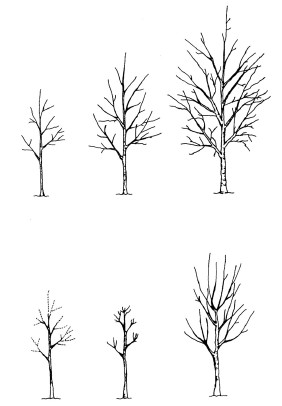I thought I would share some thoughts prompted by a row of oak trees (Quercus robur) that I often pass whilst walking the dog. This particular row of trees comprises some fine specimens, but also several rather poor examples, and a couple that look decidedly sick. So why the differences?

Line of English Oaks at Rectory Farm, Alderbury, Wilts.: note the two poor trees either side of a former gateway, at the right hand end.
The poorest trees are either side of a gap, which the farmer confirms used to be a gateway, so my first thought was that soil compaction (or even a diesel spill) might be to blame. But, on closer inspection, both trees – which are clearly of different age – have very short main stems, with multiple main branches from only 1.5 – 2 metres height. In fact several of the trees exhibit this poor growth habit whilst, in contrast, others are much taller, with strong vertical main trunks and excellent overall form. Curiously, many of the trees are quite old – I estimate they range from 80 to >200 years – so whatever is causing the poor habit certainly isn’t killing the trees.
These fields are not recent: the field pattern is characteristic of ancient countryside, and the fields may have been formed by “assarting” – the clearing of a patch of woodland to form a field leaving a narrow strip of the wood as a shaw or shelter belt between the new field and the existing fields: over the years this strip would be nibbled away by ploughing etc., but would continue to reflect the original woodland flora. Hence our line of oaks.
Then I remembered that our village has at least 7 different soil types, including loam, chalk, clay, free-draining sand and gravel; in geological terms it is a landslipped terrain of “London Clays” and “Reading Beds”, overlaid by “Bagshot Beds”. Even walking across a single field you can go from well drained red loam to boggy black peaty soil, to yellow sand. And therein lies what I think is the explanation – below a thin topsoil there is variously sand or clay. As the young oak trees tried to establish, some found an ideal moisture-retentive clay soil, whilst others sent their roots into free-draining sand, and consequently suffered recurrent summer droughts. Particularly during early life, a drought period would cause a tree to suffer tip die-back on the trunk and branches. When wet weather returns several new shoots often emerge from the living tissue behind the dead tips, and these shoots become equally dominant with the main trunk. The result is a weak, inferior structured tree.

A tree of high quality that receives adequate water during establishment (Top) develops good structure, while trees that suffer drought (Bottom) die back and can develop multiple trunks or other types of poor form.
So, aside from demonstrating the adaptability of Quercus robur, perhaps this line of trees is a rather nice illustration of the importance of matching plants to soil conditions. …… Well, that’s my theory. If anyone has any alternative suggestions please do leave a comment.




